Comprehensive Business Report: Starbucks' Strategy and Stakeholders
VerifiedAdded on 2023/01/17
|18
|5230
|100
Report
AI Summary
This business report offers a comprehensive analysis of Starbucks, examining its external and internal environments. The report begins with an introduction to Starbucks, followed by an external environment analysis utilizing PESTLE and Porter's Five Forces frameworks to assess political, economic, social, technological, legal, and environmental factors, as well as competitive dynamics. An internal environment analysis employs VRIO and Value Chain analyses to evaluate Starbucks' resources and capabilities. The report then provides strategic recommendations. Furthermore, a stakeholder analysis is conducted, identifying key stakeholders and assessing their power and interest. The report concludes with a summary of findings and a discussion of Starbucks' strategic position in the coffee industry.
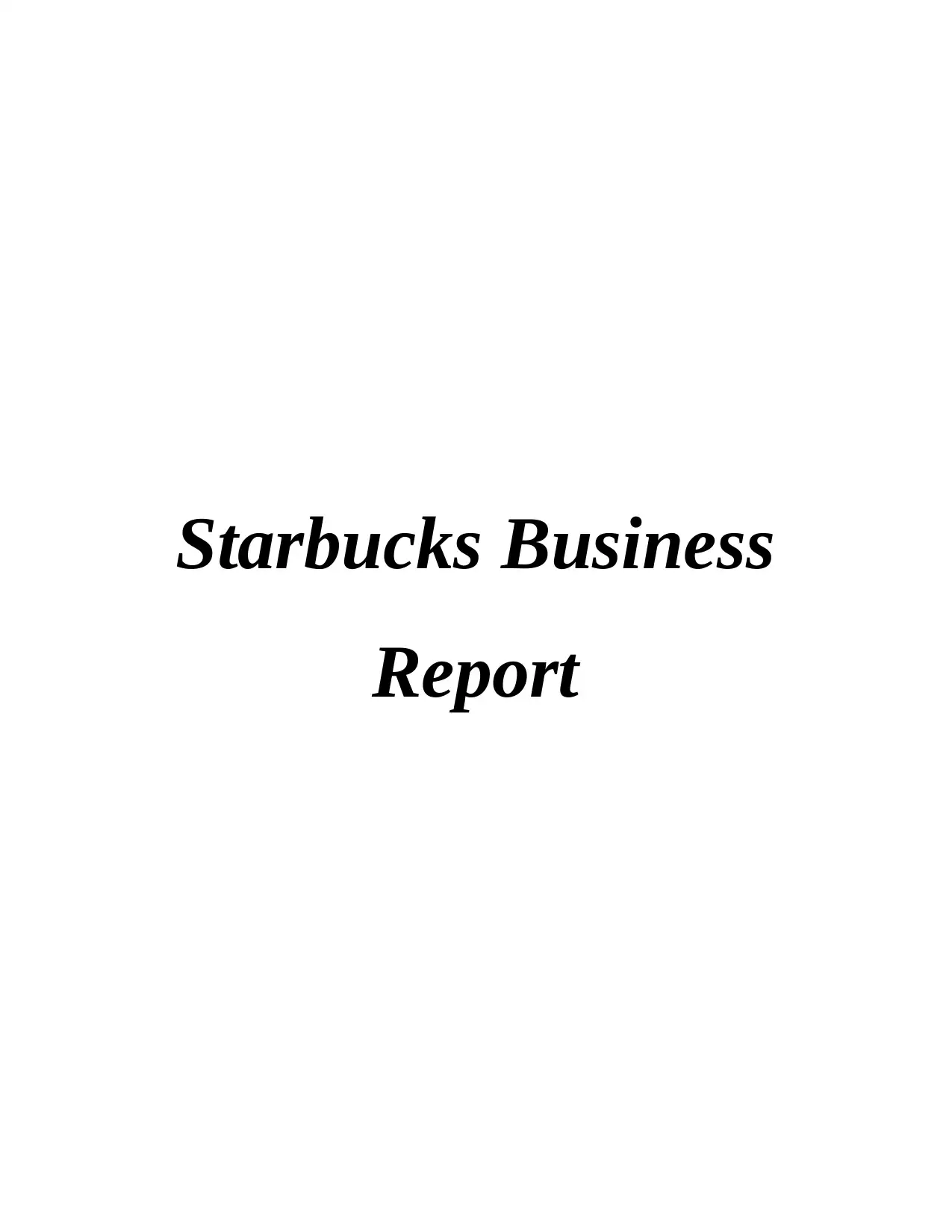
Starbucks Business
Report
Report
Paraphrase This Document
Need a fresh take? Get an instant paraphrase of this document with our AI Paraphraser
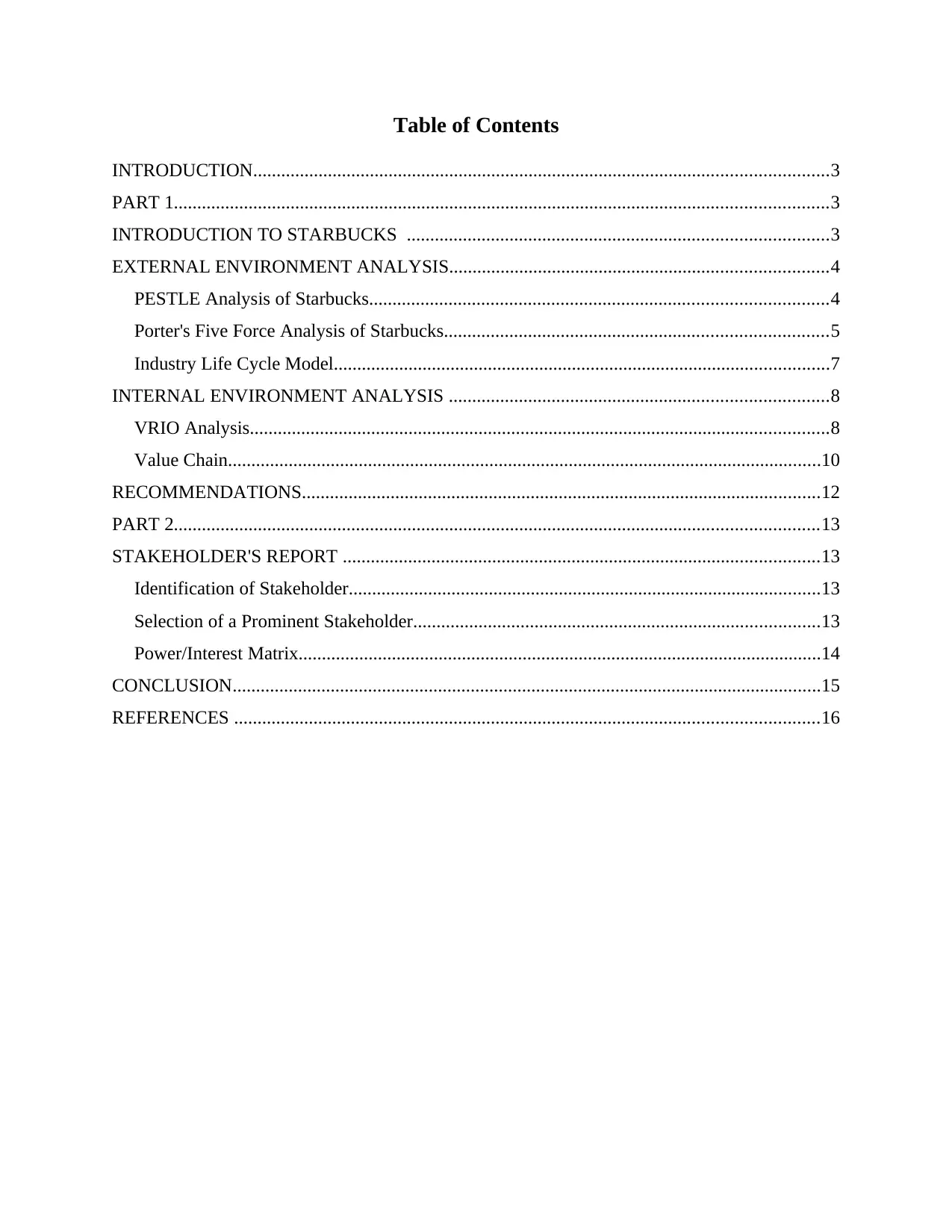
Table of Contents
INTRODUCTION...........................................................................................................................3
PART 1............................................................................................................................................3
INTRODUCTION TO STARBUCKS ..........................................................................................3
EXTERNAL ENVIRONMENT ANALYSIS.................................................................................4
PESTLE Analysis of Starbucks..................................................................................................4
Porter's Five Force Analysis of Starbucks..................................................................................5
Industry Life Cycle Model..........................................................................................................7
INTERNAL ENVIRONMENT ANALYSIS .................................................................................8
VRIO Analysis............................................................................................................................8
Value Chain...............................................................................................................................10
RECOMMENDATIONS...............................................................................................................12
PART 2..........................................................................................................................................13
STAKEHOLDER'S REPORT ......................................................................................................13
Identification of Stakeholder.....................................................................................................13
Selection of a Prominent Stakeholder.......................................................................................13
Power/Interest Matrix................................................................................................................14
CONCLUSION..............................................................................................................................15
REFERENCES .............................................................................................................................16
INTRODUCTION...........................................................................................................................3
PART 1............................................................................................................................................3
INTRODUCTION TO STARBUCKS ..........................................................................................3
EXTERNAL ENVIRONMENT ANALYSIS.................................................................................4
PESTLE Analysis of Starbucks..................................................................................................4
Porter's Five Force Analysis of Starbucks..................................................................................5
Industry Life Cycle Model..........................................................................................................7
INTERNAL ENVIRONMENT ANALYSIS .................................................................................8
VRIO Analysis............................................................................................................................8
Value Chain...............................................................................................................................10
RECOMMENDATIONS...............................................................................................................12
PART 2..........................................................................................................................................13
STAKEHOLDER'S REPORT ......................................................................................................13
Identification of Stakeholder.....................................................................................................13
Selection of a Prominent Stakeholder.......................................................................................13
Power/Interest Matrix................................................................................................................14
CONCLUSION..............................................................................................................................15
REFERENCES .............................................................................................................................16
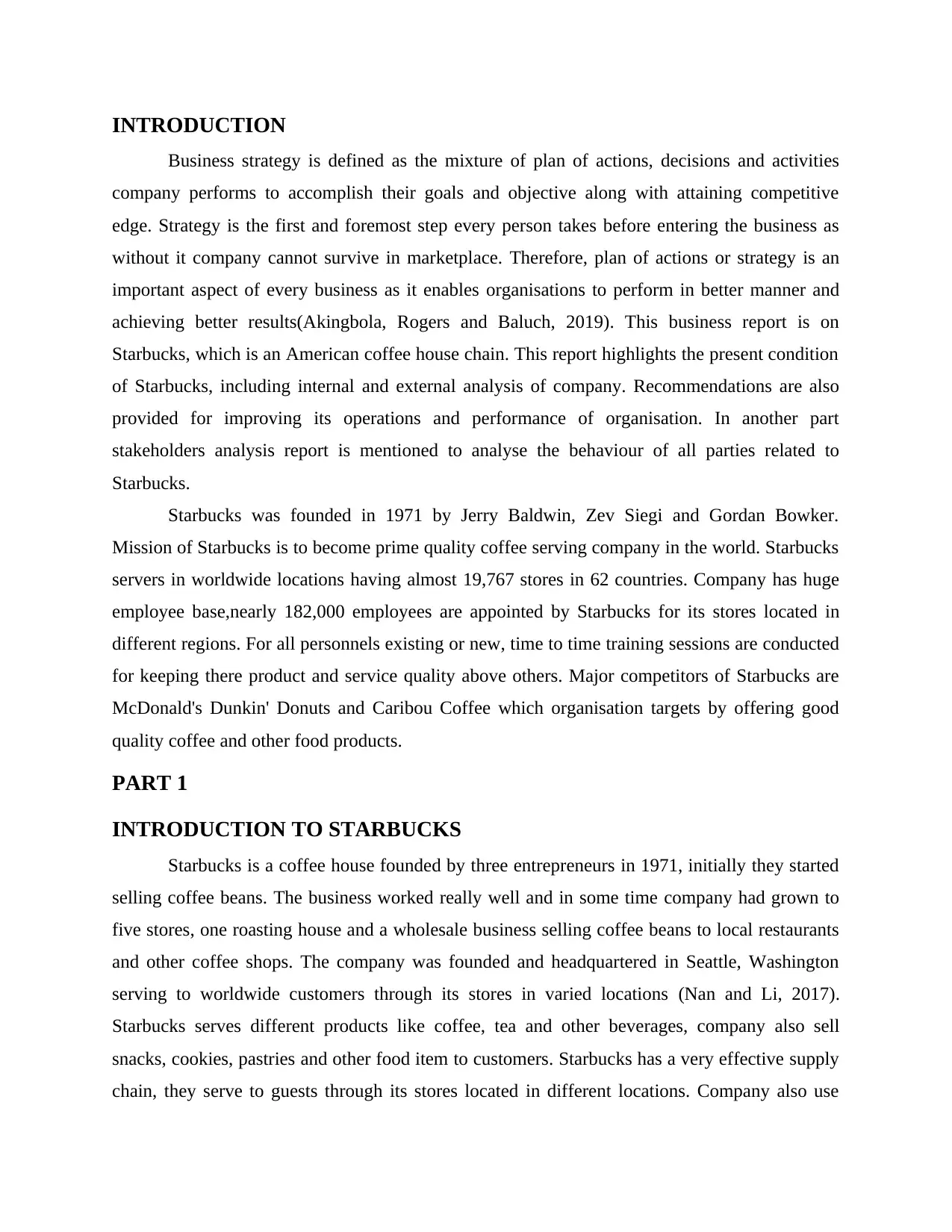
INTRODUCTION
Business strategy is defined as the mixture of plan of actions, decisions and activities
company performs to accomplish their goals and objective along with attaining competitive
edge. Strategy is the first and foremost step every person takes before entering the business as
without it company cannot survive in marketplace. Therefore, plan of actions or strategy is an
important aspect of every business as it enables organisations to perform in better manner and
achieving better results(Akingbola, Rogers and Baluch, 2019). This business report is on
Starbucks, which is an American coffee house chain. This report highlights the present condition
of Starbucks, including internal and external analysis of company. Recommendations are also
provided for improving its operations and performance of organisation. In another part
stakeholders analysis report is mentioned to analyse the behaviour of all parties related to
Starbucks.
Starbucks was founded in 1971 by Jerry Baldwin, Zev Siegi and Gordan Bowker.
Mission of Starbucks is to become prime quality coffee serving company in the world. Starbucks
servers in worldwide locations having almost 19,767 stores in 62 countries. Company has huge
employee base,nearly 182,000 employees are appointed by Starbucks for its stores located in
different regions. For all personnels existing or new, time to time training sessions are conducted
for keeping there product and service quality above others. Major competitors of Starbucks are
McDonald's Dunkin' Donuts and Caribou Coffee which organisation targets by offering good
quality coffee and other food products.
PART 1
INTRODUCTION TO STARBUCKS
Starbucks is a coffee house founded by three entrepreneurs in 1971, initially they started
selling coffee beans. The business worked really well and in some time company had grown to
five stores, one roasting house and a wholesale business selling coffee beans to local restaurants
and other coffee shops. The company was founded and headquartered in Seattle, Washington
serving to worldwide customers through its stores in varied locations (Nan and Li, 2017).
Starbucks serves different products like coffee, tea and other beverages, company also sell
snacks, cookies, pastries and other food item to customers. Starbucks has a very effective supply
chain, they serve to guests through its stores located in different locations. Company also use
Business strategy is defined as the mixture of plan of actions, decisions and activities
company performs to accomplish their goals and objective along with attaining competitive
edge. Strategy is the first and foremost step every person takes before entering the business as
without it company cannot survive in marketplace. Therefore, plan of actions or strategy is an
important aspect of every business as it enables organisations to perform in better manner and
achieving better results(Akingbola, Rogers and Baluch, 2019). This business report is on
Starbucks, which is an American coffee house chain. This report highlights the present condition
of Starbucks, including internal and external analysis of company. Recommendations are also
provided for improving its operations and performance of organisation. In another part
stakeholders analysis report is mentioned to analyse the behaviour of all parties related to
Starbucks.
Starbucks was founded in 1971 by Jerry Baldwin, Zev Siegi and Gordan Bowker.
Mission of Starbucks is to become prime quality coffee serving company in the world. Starbucks
servers in worldwide locations having almost 19,767 stores in 62 countries. Company has huge
employee base,nearly 182,000 employees are appointed by Starbucks for its stores located in
different regions. For all personnels existing or new, time to time training sessions are conducted
for keeping there product and service quality above others. Major competitors of Starbucks are
McDonald's Dunkin' Donuts and Caribou Coffee which organisation targets by offering good
quality coffee and other food products.
PART 1
INTRODUCTION TO STARBUCKS
Starbucks is a coffee house founded by three entrepreneurs in 1971, initially they started
selling coffee beans. The business worked really well and in some time company had grown to
five stores, one roasting house and a wholesale business selling coffee beans to local restaurants
and other coffee shops. The company was founded and headquartered in Seattle, Washington
serving to worldwide customers through its stores in varied locations (Nan and Li, 2017).
Starbucks serves different products like coffee, tea and other beverages, company also sell
snacks, cookies, pastries and other food item to customers. Starbucks has a very effective supply
chain, they serve to guests through its stores located in different locations. Company also use
⊘ This is a preview!⊘
Do you want full access?
Subscribe today to unlock all pages.

Trusted by 1+ million students worldwide
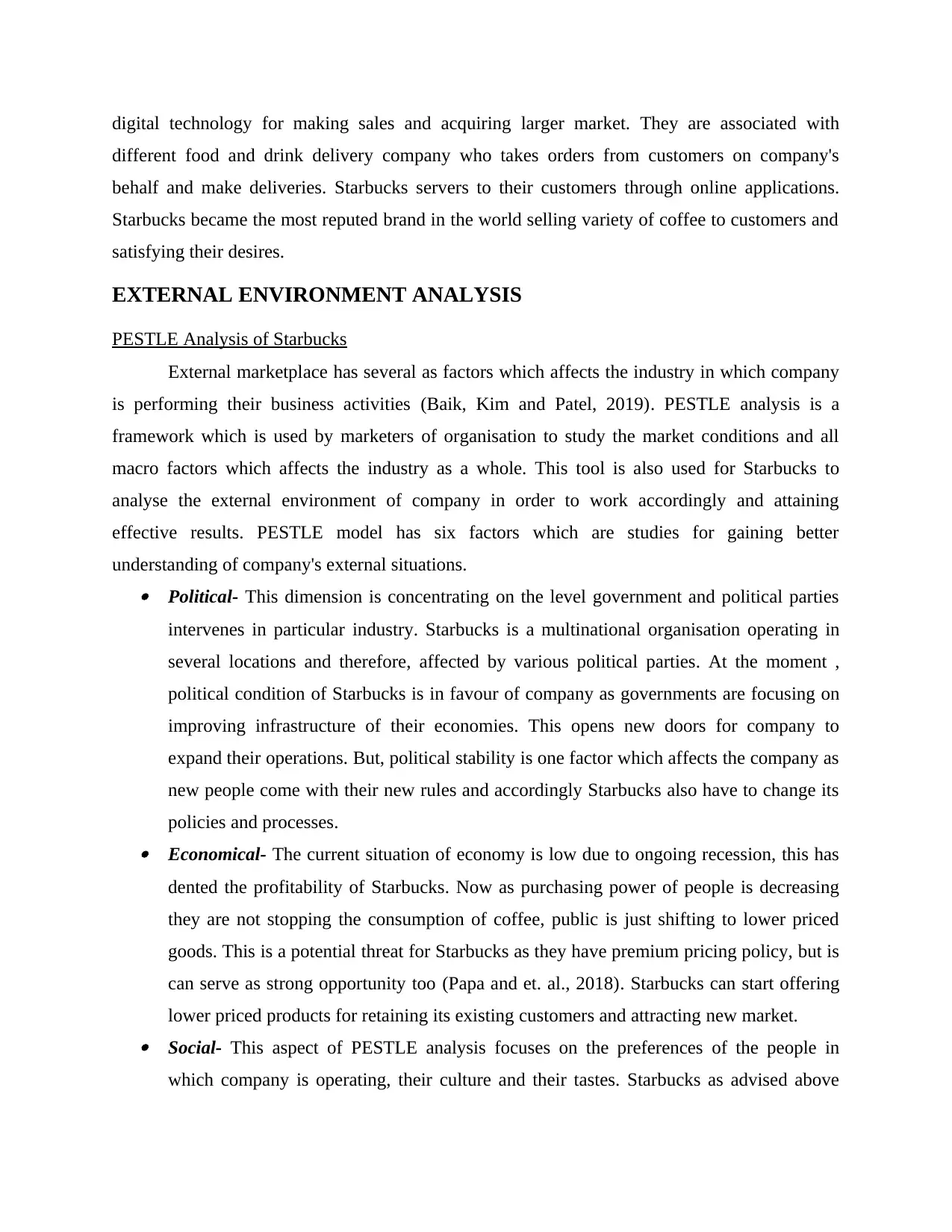
digital technology for making sales and acquiring larger market. They are associated with
different food and drink delivery company who takes orders from customers on company's
behalf and make deliveries. Starbucks servers to their customers through online applications.
Starbucks became the most reputed brand in the world selling variety of coffee to customers and
satisfying their desires.
EXTERNAL ENVIRONMENT ANALYSIS
PESTLE Analysis of Starbucks
External marketplace has several as factors which affects the industry in which company
is performing their business activities (Baik, Kim and Patel, 2019). PESTLE analysis is a
framework which is used by marketers of organisation to study the market conditions and all
macro factors which affects the industry as a whole. This tool is also used for Starbucks to
analyse the external environment of company in order to work accordingly and attaining
effective results. PESTLE model has six factors which are studies for gaining better
understanding of company's external situations. Political- This dimension is concentrating on the level government and political parties
intervenes in particular industry. Starbucks is a multinational organisation operating in
several locations and therefore, affected by various political parties. At the moment ,
political condition of Starbucks is in favour of company as governments are focusing on
improving infrastructure of their economies. This opens new doors for company to
expand their operations. But, political stability is one factor which affects the company as
new people come with their new rules and accordingly Starbucks also have to change its
policies and processes. Economical- The current situation of economy is low due to ongoing recession, this has
dented the profitability of Starbucks. Now as purchasing power of people is decreasing
they are not stopping the consumption of coffee, public is just shifting to lower priced
goods. This is a potential threat for Starbucks as they have premium pricing policy, but is
can serve as strong opportunity too (Papa and et. al., 2018). Starbucks can start offering
lower priced products for retaining its existing customers and attracting new market. Social- This aspect of PESTLE analysis focuses on the preferences of the people in
which company is operating, their culture and their tastes. Starbucks as advised above
different food and drink delivery company who takes orders from customers on company's
behalf and make deliveries. Starbucks servers to their customers through online applications.
Starbucks became the most reputed brand in the world selling variety of coffee to customers and
satisfying their desires.
EXTERNAL ENVIRONMENT ANALYSIS
PESTLE Analysis of Starbucks
External marketplace has several as factors which affects the industry in which company
is performing their business activities (Baik, Kim and Patel, 2019). PESTLE analysis is a
framework which is used by marketers of organisation to study the market conditions and all
macro factors which affects the industry as a whole. This tool is also used for Starbucks to
analyse the external environment of company in order to work accordingly and attaining
effective results. PESTLE model has six factors which are studies for gaining better
understanding of company's external situations. Political- This dimension is concentrating on the level government and political parties
intervenes in particular industry. Starbucks is a multinational organisation operating in
several locations and therefore, affected by various political parties. At the moment ,
political condition of Starbucks is in favour of company as governments are focusing on
improving infrastructure of their economies. This opens new doors for company to
expand their operations. But, political stability is one factor which affects the company as
new people come with their new rules and accordingly Starbucks also have to change its
policies and processes. Economical- The current situation of economy is low due to ongoing recession, this has
dented the profitability of Starbucks. Now as purchasing power of people is decreasing
they are not stopping the consumption of coffee, public is just shifting to lower priced
goods. This is a potential threat for Starbucks as they have premium pricing policy, but is
can serve as strong opportunity too (Papa and et. al., 2018). Starbucks can start offering
lower priced products for retaining its existing customers and attracting new market. Social- This aspect of PESTLE analysis focuses on the preferences of the people in
which company is operating, their culture and their tastes. Starbucks as advised above
Paraphrase This Document
Need a fresh take? Get an instant paraphrase of this document with our AI Paraphraser
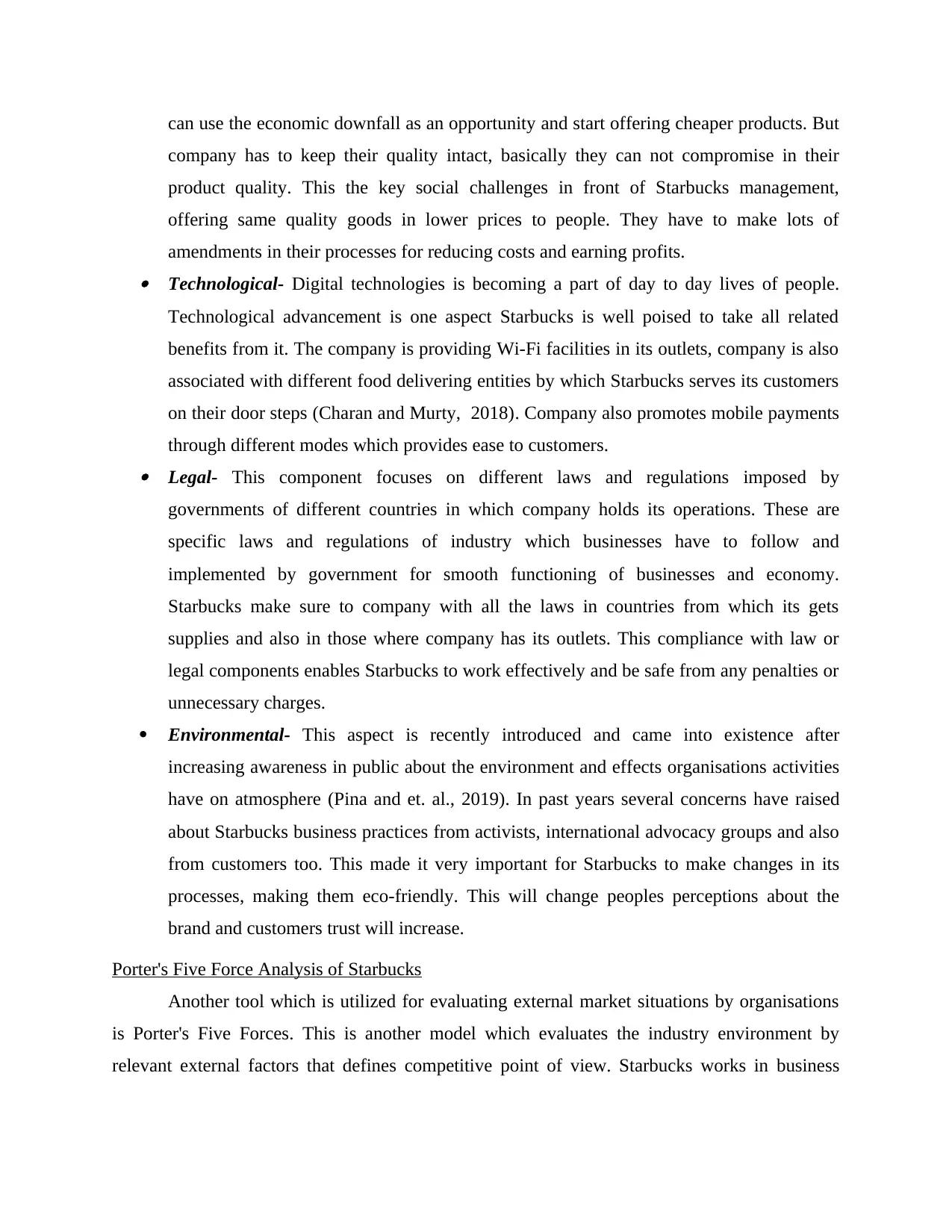
can use the economic downfall as an opportunity and start offering cheaper products. But
company has to keep their quality intact, basically they can not compromise in their
product quality. This the key social challenges in front of Starbucks management,
offering same quality goods in lower prices to people. They have to make lots of
amendments in their processes for reducing costs and earning profits. Technological- Digital technologies is becoming a part of day to day lives of people.
Technological advancement is one aspect Starbucks is well poised to take all related
benefits from it. The company is providing Wi-Fi facilities in its outlets, company is also
associated with different food delivering entities by which Starbucks serves its customers
on their door steps (Charan and Murty, 2018). Company also promotes mobile payments
through different modes which provides ease to customers. Legal- This component focuses on different laws and regulations imposed by
governments of different countries in which company holds its operations. These are
specific laws and regulations of industry which businesses have to follow and
implemented by government for smooth functioning of businesses and economy.
Starbucks make sure to company with all the laws in countries from which its gets
supplies and also in those where company has its outlets. This compliance with law or
legal components enables Starbucks to work effectively and be safe from any penalties or
unnecessary charges.
Environmental- This aspect is recently introduced and came into existence after
increasing awareness in public about the environment and effects organisations activities
have on atmosphere (Pina and et. al., 2019). In past years several concerns have raised
about Starbucks business practices from activists, international advocacy groups and also
from customers too. This made it very important for Starbucks to make changes in its
processes, making them eco-friendly. This will change peoples perceptions about the
brand and customers trust will increase.
Porter's Five Force Analysis of Starbucks
Another tool which is utilized for evaluating external market situations by organisations
is Porter's Five Forces. This is another model which evaluates the industry environment by
relevant external factors that defines competitive point of view. Starbucks works in business
company has to keep their quality intact, basically they can not compromise in their
product quality. This the key social challenges in front of Starbucks management,
offering same quality goods in lower prices to people. They have to make lots of
amendments in their processes for reducing costs and earning profits. Technological- Digital technologies is becoming a part of day to day lives of people.
Technological advancement is one aspect Starbucks is well poised to take all related
benefits from it. The company is providing Wi-Fi facilities in its outlets, company is also
associated with different food delivering entities by which Starbucks serves its customers
on their door steps (Charan and Murty, 2018). Company also promotes mobile payments
through different modes which provides ease to customers. Legal- This component focuses on different laws and regulations imposed by
governments of different countries in which company holds its operations. These are
specific laws and regulations of industry which businesses have to follow and
implemented by government for smooth functioning of businesses and economy.
Starbucks make sure to company with all the laws in countries from which its gets
supplies and also in those where company has its outlets. This compliance with law or
legal components enables Starbucks to work effectively and be safe from any penalties or
unnecessary charges.
Environmental- This aspect is recently introduced and came into existence after
increasing awareness in public about the environment and effects organisations activities
have on atmosphere (Pina and et. al., 2019). In past years several concerns have raised
about Starbucks business practices from activists, international advocacy groups and also
from customers too. This made it very important for Starbucks to make changes in its
processes, making them eco-friendly. This will change peoples perceptions about the
brand and customers trust will increase.
Porter's Five Force Analysis of Starbucks
Another tool which is utilized for evaluating external market situations by organisations
is Porter's Five Forces. This is another model which evaluates the industry environment by
relevant external factors that defines competitive point of view. Starbucks works in business
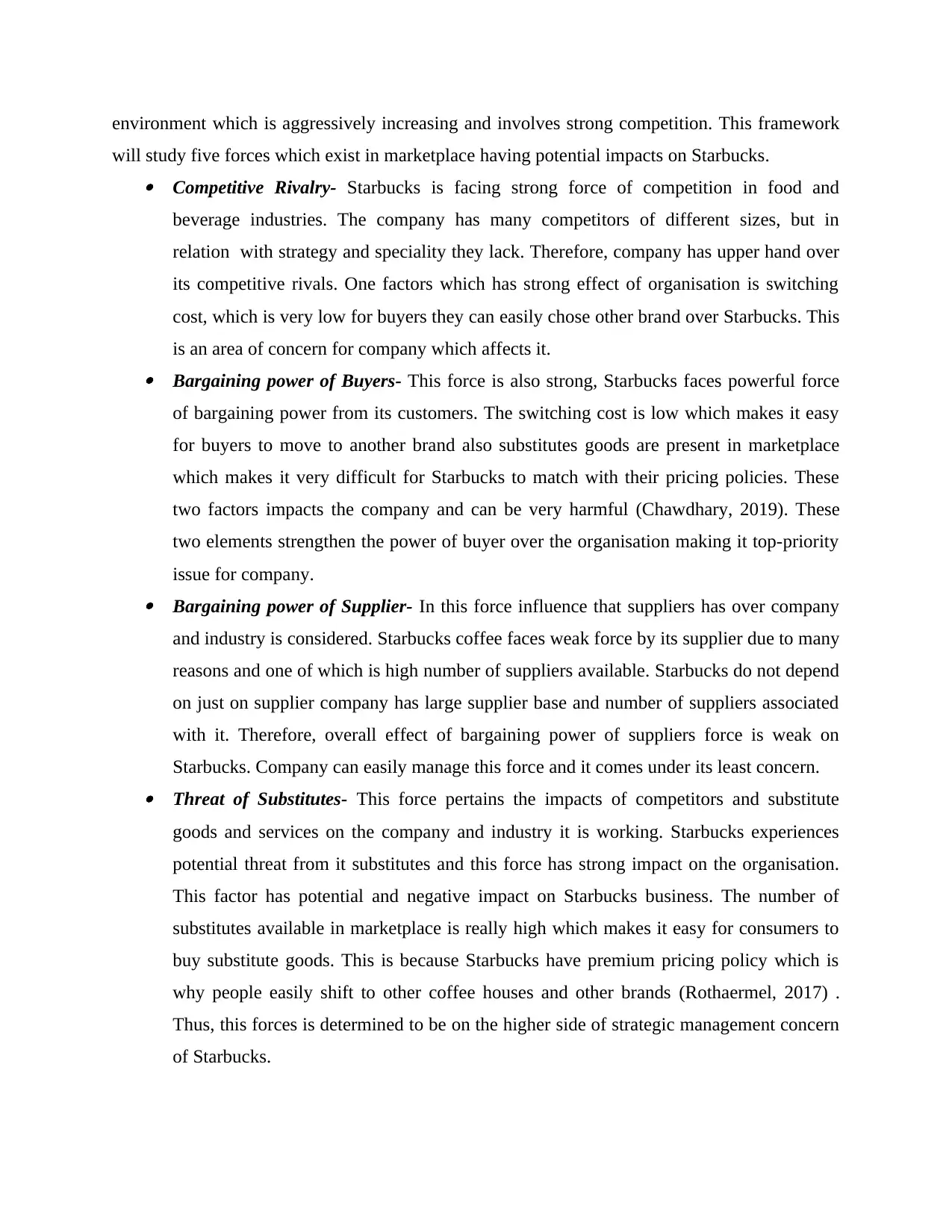
environment which is aggressively increasing and involves strong competition. This framework
will study five forces which exist in marketplace having potential impacts on Starbucks. Competitive Rivalry- Starbucks is facing strong force of competition in food and
beverage industries. The company has many competitors of different sizes, but in
relation with strategy and speciality they lack. Therefore, company has upper hand over
its competitive rivals. One factors which has strong effect of organisation is switching
cost, which is very low for buyers they can easily chose other brand over Starbucks. This
is an area of concern for company which affects it. Bargaining power of Buyers- This force is also strong, Starbucks faces powerful force
of bargaining power from its customers. The switching cost is low which makes it easy
for buyers to move to another brand also substitutes goods are present in marketplace
which makes it very difficult for Starbucks to match with their pricing policies. These
two factors impacts the company and can be very harmful (Chawdhary, 2019). These
two elements strengthen the power of buyer over the organisation making it top-priority
issue for company. Bargaining power of Supplier- In this force influence that suppliers has over company
and industry is considered. Starbucks coffee faces weak force by its supplier due to many
reasons and one of which is high number of suppliers available. Starbucks do not depend
on just on supplier company has large supplier base and number of suppliers associated
with it. Therefore, overall effect of bargaining power of suppliers force is weak on
Starbucks. Company can easily manage this force and it comes under its least concern. Threat of Substitutes- This force pertains the impacts of competitors and substitute
goods and services on the company and industry it is working. Starbucks experiences
potential threat from it substitutes and this force has strong impact on the organisation.
This factor has potential and negative impact on Starbucks business. The number of
substitutes available in marketplace is really high which makes it easy for consumers to
buy substitute goods. This is because Starbucks have premium pricing policy which is
why people easily shift to other coffee houses and other brands (Rothaermel, 2017) .
Thus, this forces is determined to be on the higher side of strategic management concern
of Starbucks.
will study five forces which exist in marketplace having potential impacts on Starbucks. Competitive Rivalry- Starbucks is facing strong force of competition in food and
beverage industries. The company has many competitors of different sizes, but in
relation with strategy and speciality they lack. Therefore, company has upper hand over
its competitive rivals. One factors which has strong effect of organisation is switching
cost, which is very low for buyers they can easily chose other brand over Starbucks. This
is an area of concern for company which affects it. Bargaining power of Buyers- This force is also strong, Starbucks faces powerful force
of bargaining power from its customers. The switching cost is low which makes it easy
for buyers to move to another brand also substitutes goods are present in marketplace
which makes it very difficult for Starbucks to match with their pricing policies. These
two factors impacts the company and can be very harmful (Chawdhary, 2019). These
two elements strengthen the power of buyer over the organisation making it top-priority
issue for company. Bargaining power of Supplier- In this force influence that suppliers has over company
and industry is considered. Starbucks coffee faces weak force by its supplier due to many
reasons and one of which is high number of suppliers available. Starbucks do not depend
on just on supplier company has large supplier base and number of suppliers associated
with it. Therefore, overall effect of bargaining power of suppliers force is weak on
Starbucks. Company can easily manage this force and it comes under its least concern. Threat of Substitutes- This force pertains the impacts of competitors and substitute
goods and services on the company and industry it is working. Starbucks experiences
potential threat from it substitutes and this force has strong impact on the organisation.
This factor has potential and negative impact on Starbucks business. The number of
substitutes available in marketplace is really high which makes it easy for consumers to
buy substitute goods. This is because Starbucks have premium pricing policy which is
why people easily shift to other coffee houses and other brands (Rothaermel, 2017) .
Thus, this forces is determined to be on the higher side of strategic management concern
of Starbucks.
⊘ This is a preview!⊘
Do you want full access?
Subscribe today to unlock all pages.

Trusted by 1+ million students worldwide
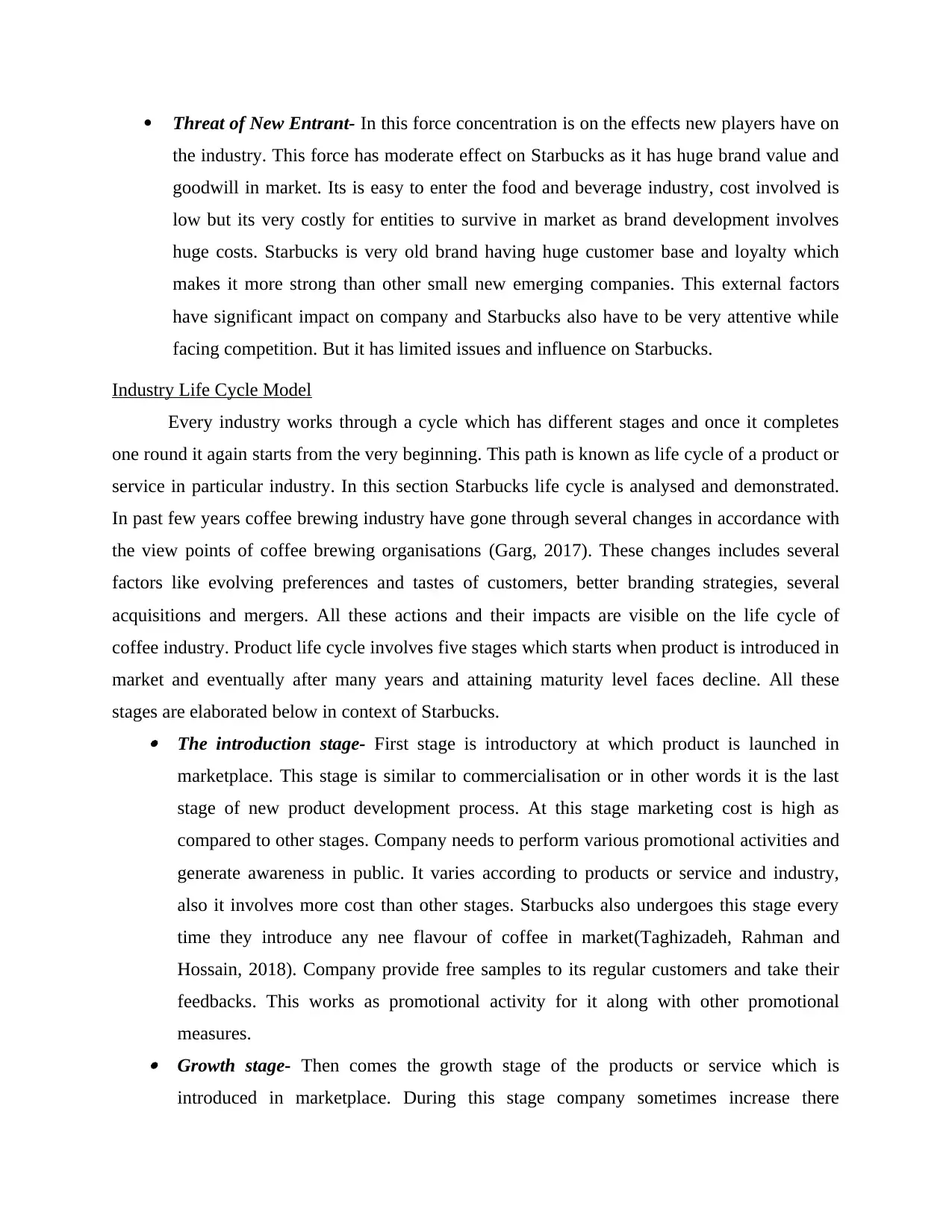
Threat of New Entrant- In this force concentration is on the effects new players have on
the industry. This force has moderate effect on Starbucks as it has huge brand value and
goodwill in market. Its is easy to enter the food and beverage industry, cost involved is
low but its very costly for entities to survive in market as brand development involves
huge costs. Starbucks is very old brand having huge customer base and loyalty which
makes it more strong than other small new emerging companies. This external factors
have significant impact on company and Starbucks also have to be very attentive while
facing competition. But it has limited issues and influence on Starbucks.
Industry Life Cycle Model
Every industry works through a cycle which has different stages and once it completes
one round it again starts from the very beginning. This path is known as life cycle of a product or
service in particular industry. In this section Starbucks life cycle is analysed and demonstrated.
In past few years coffee brewing industry have gone through several changes in accordance with
the view points of coffee brewing organisations (Garg, 2017). These changes includes several
factors like evolving preferences and tastes of customers, better branding strategies, several
acquisitions and mergers. All these actions and their impacts are visible on the life cycle of
coffee industry. Product life cycle involves five stages which starts when product is introduced in
market and eventually after many years and attaining maturity level faces decline. All these
stages are elaborated below in context of Starbucks. The introduction stage- First stage is introductory at which product is launched in
marketplace. This stage is similar to commercialisation or in other words it is the last
stage of new product development process. At this stage marketing cost is high as
compared to other stages. Company needs to perform various promotional activities and
generate awareness in public. It varies according to products or service and industry,
also it involves more cost than other stages. Starbucks also undergoes this stage every
time they introduce any nee flavour of coffee in market(Taghizadeh, Rahman and
Hossain, 2018). Company provide free samples to its regular customers and take their
feedbacks. This works as promotional activity for it along with other promotional
measures. Growth stage- Then comes the growth stage of the products or service which is
introduced in marketplace. During this stage company sometimes increase there
the industry. This force has moderate effect on Starbucks as it has huge brand value and
goodwill in market. Its is easy to enter the food and beverage industry, cost involved is
low but its very costly for entities to survive in market as brand development involves
huge costs. Starbucks is very old brand having huge customer base and loyalty which
makes it more strong than other small new emerging companies. This external factors
have significant impact on company and Starbucks also have to be very attentive while
facing competition. But it has limited issues and influence on Starbucks.
Industry Life Cycle Model
Every industry works through a cycle which has different stages and once it completes
one round it again starts from the very beginning. This path is known as life cycle of a product or
service in particular industry. In this section Starbucks life cycle is analysed and demonstrated.
In past few years coffee brewing industry have gone through several changes in accordance with
the view points of coffee brewing organisations (Garg, 2017). These changes includes several
factors like evolving preferences and tastes of customers, better branding strategies, several
acquisitions and mergers. All these actions and their impacts are visible on the life cycle of
coffee industry. Product life cycle involves five stages which starts when product is introduced in
market and eventually after many years and attaining maturity level faces decline. All these
stages are elaborated below in context of Starbucks. The introduction stage- First stage is introductory at which product is launched in
marketplace. This stage is similar to commercialisation or in other words it is the last
stage of new product development process. At this stage marketing cost is high as
compared to other stages. Company needs to perform various promotional activities and
generate awareness in public. It varies according to products or service and industry,
also it involves more cost than other stages. Starbucks also undergoes this stage every
time they introduce any nee flavour of coffee in market(Taghizadeh, Rahman and
Hossain, 2018). Company provide free samples to its regular customers and take their
feedbacks. This works as promotional activity for it along with other promotional
measures. Growth stage- Then comes the growth stage of the products or service which is
introduced in marketplace. During this stage company sometimes increase there
Paraphrase This Document
Need a fresh take? Get an instant paraphrase of this document with our AI Paraphraser
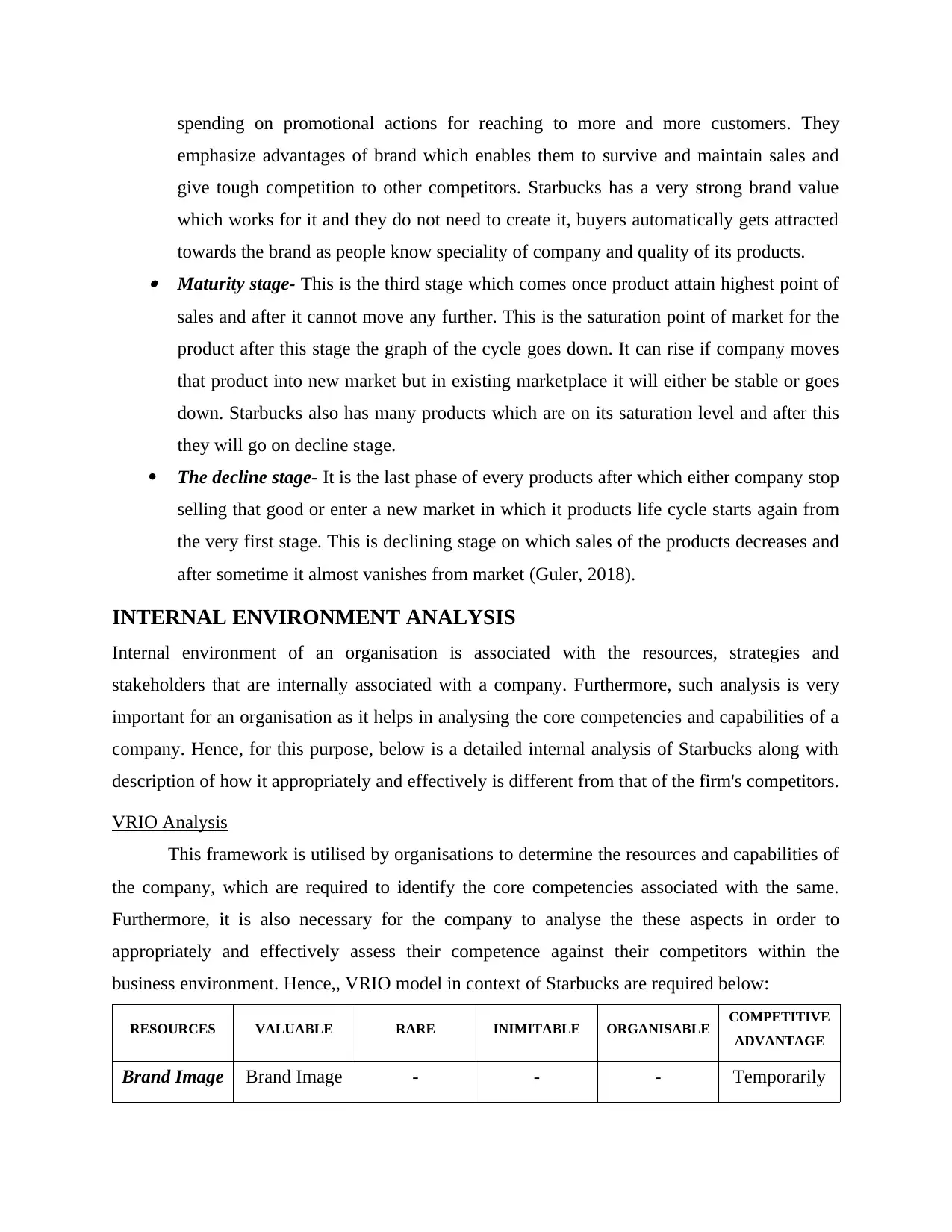
spending on promotional actions for reaching to more and more customers. They
emphasize advantages of brand which enables them to survive and maintain sales and
give tough competition to other competitors. Starbucks has a very strong brand value
which works for it and they do not need to create it, buyers automatically gets attracted
towards the brand as people know speciality of company and quality of its products. Maturity stage- This is the third stage which comes once product attain highest point of
sales and after it cannot move any further. This is the saturation point of market for the
product after this stage the graph of the cycle goes down. It can rise if company moves
that product into new market but in existing marketplace it will either be stable or goes
down. Starbucks also has many products which are on its saturation level and after this
they will go on decline stage.
The decline stage- It is the last phase of every products after which either company stop
selling that good or enter a new market in which it products life cycle starts again from
the very first stage. This is declining stage on which sales of the products decreases and
after sometime it almost vanishes from market (Guler, 2018).
INTERNAL ENVIRONMENT ANALYSIS
Internal environment of an organisation is associated with the resources, strategies and
stakeholders that are internally associated with a company. Furthermore, such analysis is very
important for an organisation as it helps in analysing the core competencies and capabilities of a
company. Hence, for this purpose, below is a detailed internal analysis of Starbucks along with
description of how it appropriately and effectively is different from that of the firm's competitors.
VRIO Analysis
This framework is utilised by organisations to determine the resources and capabilities of
the company, which are required to identify the core competencies associated with the same.
Furthermore, it is also necessary for the company to analyse the these aspects in order to
appropriately and effectively assess their competence against their competitors within the
business environment. Hence,, VRIO model in context of Starbucks are required below:
RESOURCES VALUABLE RARE INIMITABLE ORGANISABLE COMPETITIVE
ADVANTAGE
Brand Image Brand Image - - - Temporarily
emphasize advantages of brand which enables them to survive and maintain sales and
give tough competition to other competitors. Starbucks has a very strong brand value
which works for it and they do not need to create it, buyers automatically gets attracted
towards the brand as people know speciality of company and quality of its products. Maturity stage- This is the third stage which comes once product attain highest point of
sales and after it cannot move any further. This is the saturation point of market for the
product after this stage the graph of the cycle goes down. It can rise if company moves
that product into new market but in existing marketplace it will either be stable or goes
down. Starbucks also has many products which are on its saturation level and after this
they will go on decline stage.
The decline stage- It is the last phase of every products after which either company stop
selling that good or enter a new market in which it products life cycle starts again from
the very first stage. This is declining stage on which sales of the products decreases and
after sometime it almost vanishes from market (Guler, 2018).
INTERNAL ENVIRONMENT ANALYSIS
Internal environment of an organisation is associated with the resources, strategies and
stakeholders that are internally associated with a company. Furthermore, such analysis is very
important for an organisation as it helps in analysing the core competencies and capabilities of a
company. Hence, for this purpose, below is a detailed internal analysis of Starbucks along with
description of how it appropriately and effectively is different from that of the firm's competitors.
VRIO Analysis
This framework is utilised by organisations to determine the resources and capabilities of
the company, which are required to identify the core competencies associated with the same.
Furthermore, it is also necessary for the company to analyse the these aspects in order to
appropriately and effectively assess their competence against their competitors within the
business environment. Hence,, VRIO model in context of Starbucks are required below:
RESOURCES VALUABLE RARE INIMITABLE ORGANISABLE COMPETITIVE
ADVANTAGE
Brand Image Brand Image - - - Temporarily
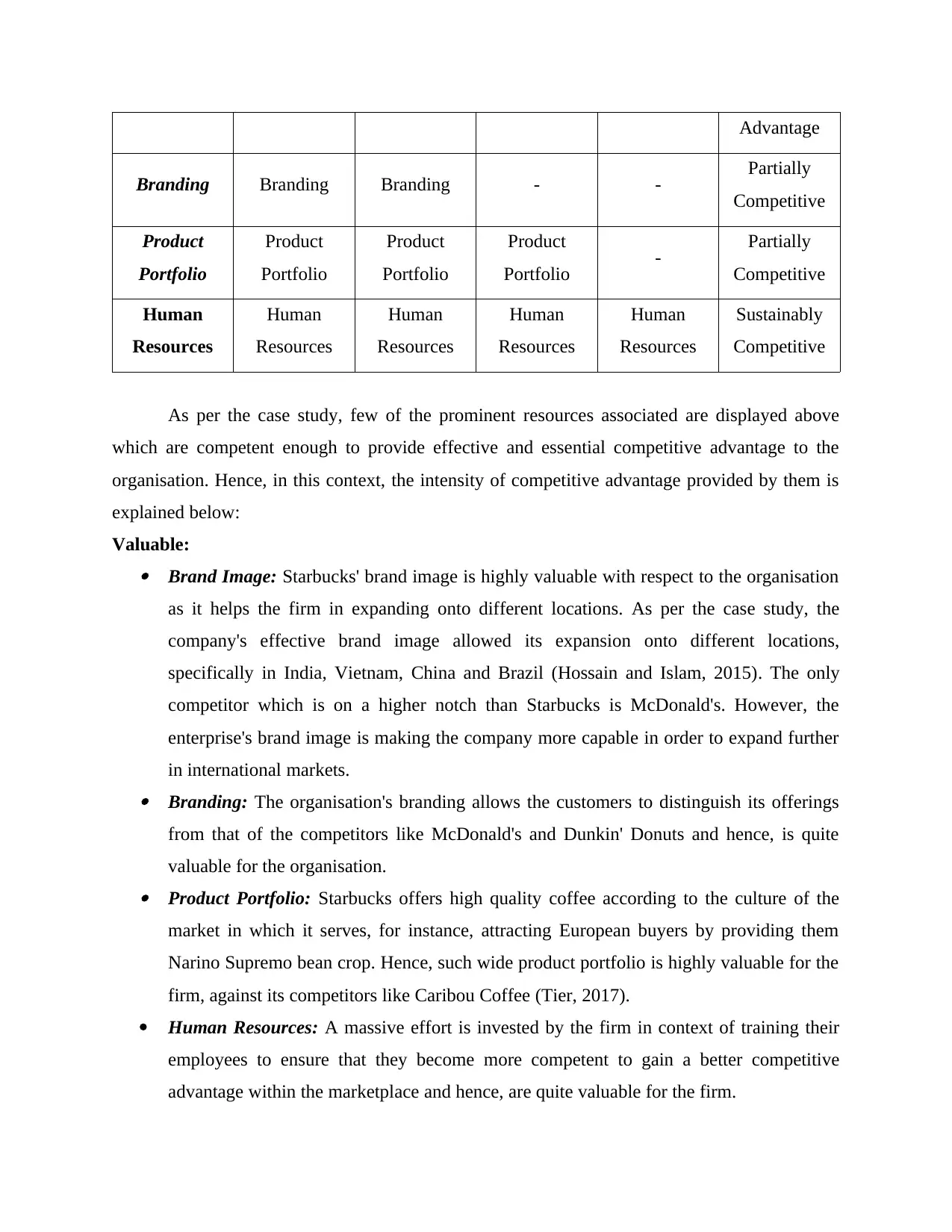
Advantage
Branding Branding Branding - - Partially
Competitive
Product
Portfolio
Product
Portfolio
Product
Portfolio
Product
Portfolio - Partially
Competitive
Human
Resources
Human
Resources
Human
Resources
Human
Resources
Human
Resources
Sustainably
Competitive
As per the case study, few of the prominent resources associated are displayed above
which are competent enough to provide effective and essential competitive advantage to the
organisation. Hence, in this context, the intensity of competitive advantage provided by them is
explained below:
Valuable: Brand Image: Starbucks' brand image is highly valuable with respect to the organisation
as it helps the firm in expanding onto different locations. As per the case study, the
company's effective brand image allowed its expansion onto different locations,
specifically in India, Vietnam, China and Brazil (Hossain and Islam, 2015). The only
competitor which is on a higher notch than Starbucks is McDonald's. However, the
enterprise's brand image is making the company more capable in order to expand further
in international markets. Branding: The organisation's branding allows the customers to distinguish its offerings
from that of the competitors like McDonald's and Dunkin' Donuts and hence, is quite
valuable for the organisation. Product Portfolio: Starbucks offers high quality coffee according to the culture of the
market in which it serves, for instance, attracting European buyers by providing them
Narino Supremo bean crop. Hence, such wide product portfolio is highly valuable for the
firm, against its competitors like Caribou Coffee (Tier, 2017).
Human Resources: A massive effort is invested by the firm in context of training their
employees to ensure that they become more competent to gain a better competitive
advantage within the marketplace and hence, are quite valuable for the firm.
Branding Branding Branding - - Partially
Competitive
Product
Portfolio
Product
Portfolio
Product
Portfolio
Product
Portfolio - Partially
Competitive
Human
Resources
Human
Resources
Human
Resources
Human
Resources
Human
Resources
Sustainably
Competitive
As per the case study, few of the prominent resources associated are displayed above
which are competent enough to provide effective and essential competitive advantage to the
organisation. Hence, in this context, the intensity of competitive advantage provided by them is
explained below:
Valuable: Brand Image: Starbucks' brand image is highly valuable with respect to the organisation
as it helps the firm in expanding onto different locations. As per the case study, the
company's effective brand image allowed its expansion onto different locations,
specifically in India, Vietnam, China and Brazil (Hossain and Islam, 2015). The only
competitor which is on a higher notch than Starbucks is McDonald's. However, the
enterprise's brand image is making the company more capable in order to expand further
in international markets. Branding: The organisation's branding allows the customers to distinguish its offerings
from that of the competitors like McDonald's and Dunkin' Donuts and hence, is quite
valuable for the organisation. Product Portfolio: Starbucks offers high quality coffee according to the culture of the
market in which it serves, for instance, attracting European buyers by providing them
Narino Supremo bean crop. Hence, such wide product portfolio is highly valuable for the
firm, against its competitors like Caribou Coffee (Tier, 2017).
Human Resources: A massive effort is invested by the firm in context of training their
employees to ensure that they become more competent to gain a better competitive
advantage within the marketplace and hence, are quite valuable for the firm.
⊘ This is a preview!⊘
Do you want full access?
Subscribe today to unlock all pages.

Trusted by 1+ million students worldwide
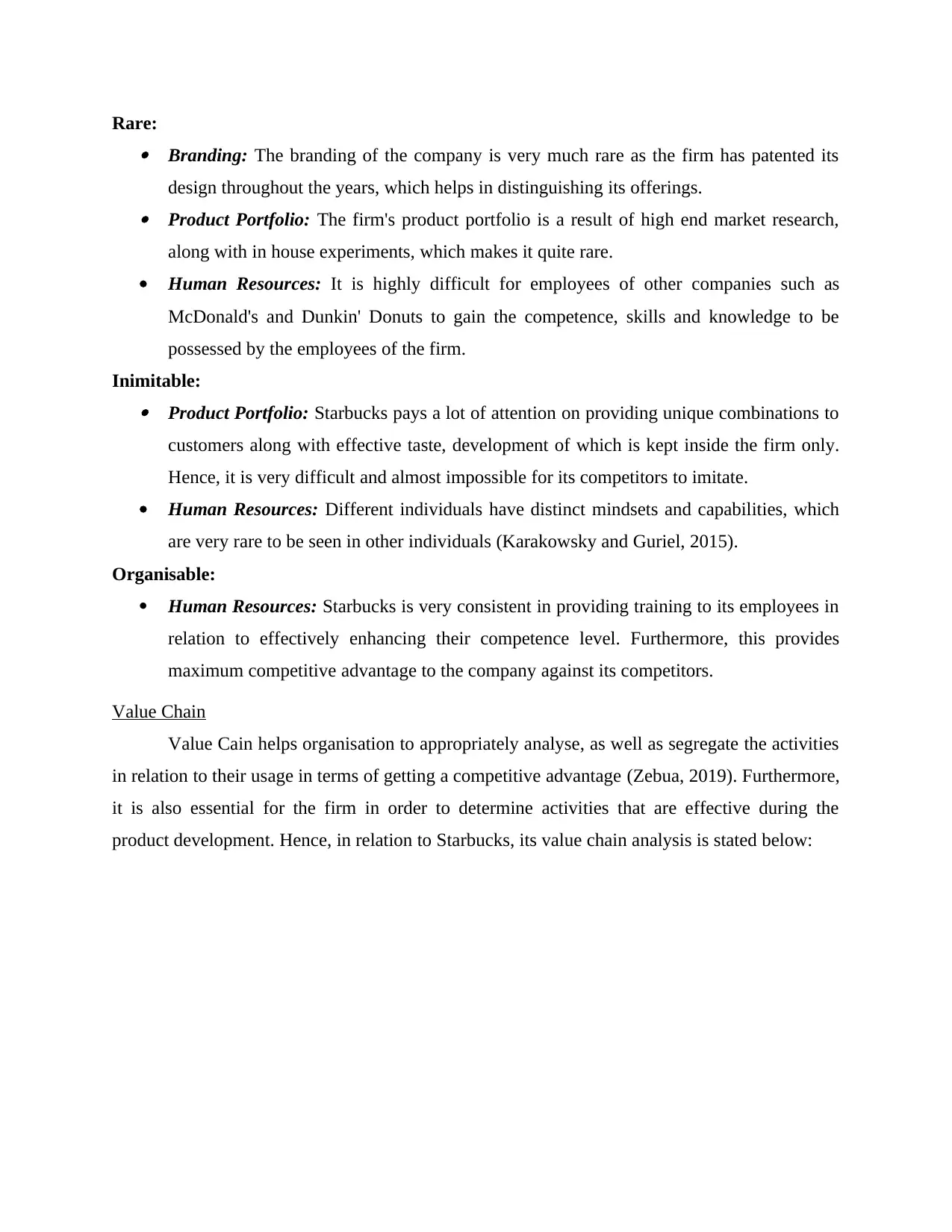
Rare: Branding: The branding of the company is very much rare as the firm has patented its
design throughout the years, which helps in distinguishing its offerings. Product Portfolio: The firm's product portfolio is a result of high end market research,
along with in house experiments, which makes it quite rare.
Human Resources: It is highly difficult for employees of other companies such as
McDonald's and Dunkin' Donuts to gain the competence, skills and knowledge to be
possessed by the employees of the firm.
Inimitable: Product Portfolio: Starbucks pays a lot of attention on providing unique combinations to
customers along with effective taste, development of which is kept inside the firm only.
Hence, it is very difficult and almost impossible for its competitors to imitate.
Human Resources: Different individuals have distinct mindsets and capabilities, which
are very rare to be seen in other individuals (Karakowsky and Guriel, 2015).
Organisable:
Human Resources: Starbucks is very consistent in providing training to its employees in
relation to effectively enhancing their competence level. Furthermore, this provides
maximum competitive advantage to the company against its competitors.
Value Chain
Value Cain helps organisation to appropriately analyse, as well as segregate the activities
in relation to their usage in terms of getting a competitive advantage (Zebua, 2019). Furthermore,
it is also essential for the firm in order to determine activities that are effective during the
product development. Hence, in relation to Starbucks, its value chain analysis is stated below:
design throughout the years, which helps in distinguishing its offerings. Product Portfolio: The firm's product portfolio is a result of high end market research,
along with in house experiments, which makes it quite rare.
Human Resources: It is highly difficult for employees of other companies such as
McDonald's and Dunkin' Donuts to gain the competence, skills and knowledge to be
possessed by the employees of the firm.
Inimitable: Product Portfolio: Starbucks pays a lot of attention on providing unique combinations to
customers along with effective taste, development of which is kept inside the firm only.
Hence, it is very difficult and almost impossible for its competitors to imitate.
Human Resources: Different individuals have distinct mindsets and capabilities, which
are very rare to be seen in other individuals (Karakowsky and Guriel, 2015).
Organisable:
Human Resources: Starbucks is very consistent in providing training to its employees in
relation to effectively enhancing their competence level. Furthermore, this provides
maximum competitive advantage to the company against its competitors.
Value Chain
Value Cain helps organisation to appropriately analyse, as well as segregate the activities
in relation to their usage in terms of getting a competitive advantage (Zebua, 2019). Furthermore,
it is also essential for the firm in order to determine activities that are effective during the
product development. Hence, in relation to Starbucks, its value chain analysis is stated below:
Paraphrase This Document
Need a fresh take? Get an instant paraphrase of this document with our AI Paraphraser

Illustration 1: Value Chain Model of Starbucks
(Source: Value Chain Model of Starbucks, 2019)
Primary Activities
Inbound Logistics
This process is inclusive of selection of finest quality coffee beans in order to ensure
development of effective coffee products within the organisation. This activity is appropriately
performed by the company by effectively producing beans within farms. Moreover, the same are
transported within the storage warehouses, where they are roasted as well as packaged.
Operations
This is another effective aspect associated with the organisation. In this context, direct
stores are appropriately operated by the firm, which undertake operations related to production of
different flavoured coffee and its service to customers (Kite, 2019).
Outbound Logistics
In relation to this type of logistics, there is a very little or limited presence of any
intermediaries while selling the offerings to the customer. This is because majority of the
products are instantly provided to customers in the licensed store.
Supporting Activities
Infrastructure
This activity is inclusive of several aspects such as finance, management, legal, sales and
so forth, which supports the operations of the firm. In this context, the company appropriately
reviews as well as modifies the same to keep up with the consistency.
Human Resource Management
(Source: Value Chain Model of Starbucks, 2019)
Primary Activities
Inbound Logistics
This process is inclusive of selection of finest quality coffee beans in order to ensure
development of effective coffee products within the organisation. This activity is appropriately
performed by the company by effectively producing beans within farms. Moreover, the same are
transported within the storage warehouses, where they are roasted as well as packaged.
Operations
This is another effective aspect associated with the organisation. In this context, direct
stores are appropriately operated by the firm, which undertake operations related to production of
different flavoured coffee and its service to customers (Kite, 2019).
Outbound Logistics
In relation to this type of logistics, there is a very little or limited presence of any
intermediaries while selling the offerings to the customer. This is because majority of the
products are instantly provided to customers in the licensed store.
Supporting Activities
Infrastructure
This activity is inclusive of several aspects such as finance, management, legal, sales and
so forth, which supports the operations of the firm. In this context, the company appropriately
reviews as well as modifies the same to keep up with the consistency.
Human Resource Management
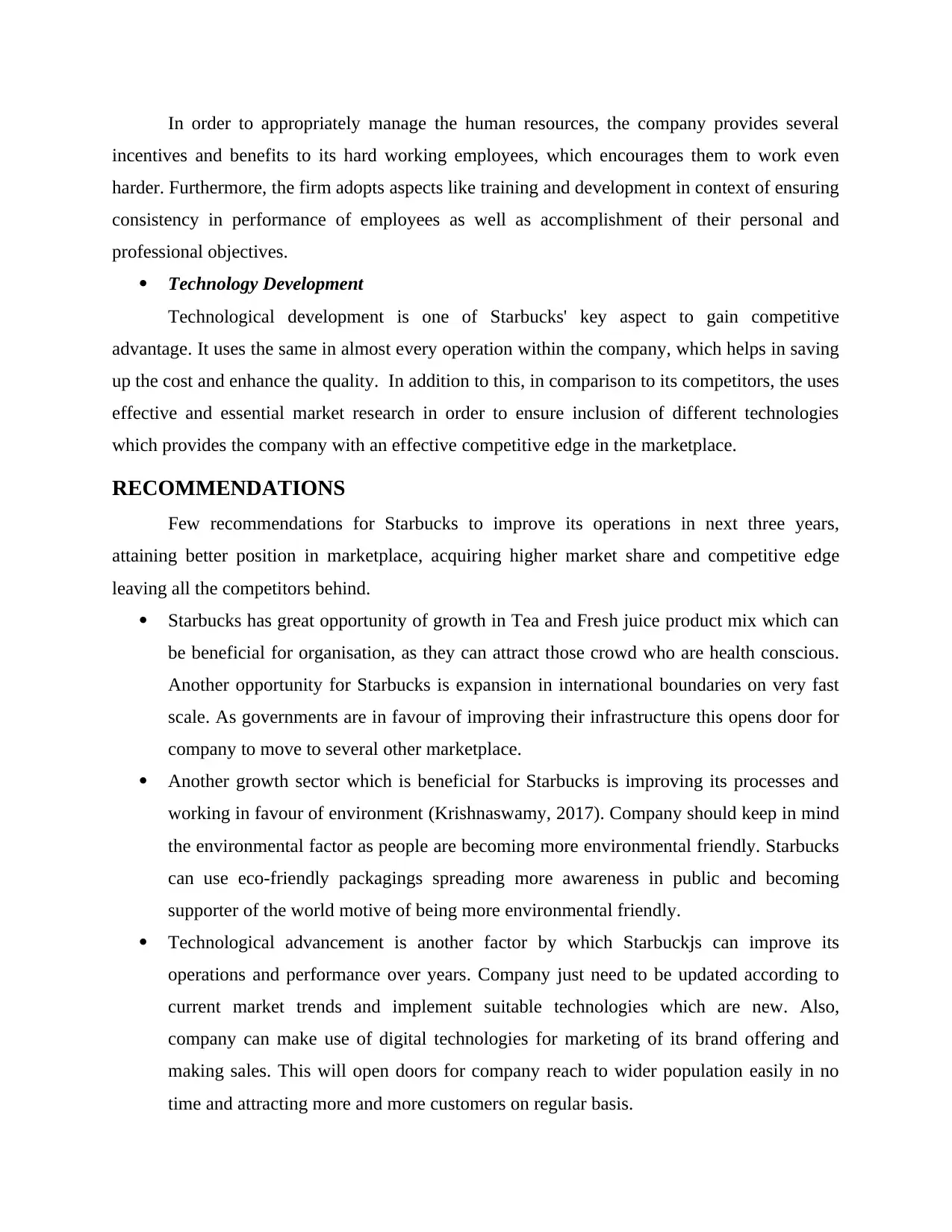
In order to appropriately manage the human resources, the company provides several
incentives and benefits to its hard working employees, which encourages them to work even
harder. Furthermore, the firm adopts aspects like training and development in context of ensuring
consistency in performance of employees as well as accomplishment of their personal and
professional objectives.
Technology Development
Technological development is one of Starbucks' key aspect to gain competitive
advantage. It uses the same in almost every operation within the company, which helps in saving
up the cost and enhance the quality. In addition to this, in comparison to its competitors, the uses
effective and essential market research in order to ensure inclusion of different technologies
which provides the company with an effective competitive edge in the marketplace.
RECOMMENDATIONS
Few recommendations for Starbucks to improve its operations in next three years,
attaining better position in marketplace, acquiring higher market share and competitive edge
leaving all the competitors behind.
Starbucks has great opportunity of growth in Tea and Fresh juice product mix which can
be beneficial for organisation, as they can attract those crowd who are health conscious.
Another opportunity for Starbucks is expansion in international boundaries on very fast
scale. As governments are in favour of improving their infrastructure this opens door for
company to move to several other marketplace.
Another growth sector which is beneficial for Starbucks is improving its processes and
working in favour of environment (Krishnaswamy, 2017). Company should keep in mind
the environmental factor as people are becoming more environmental friendly. Starbucks
can use eco-friendly packagings spreading more awareness in public and becoming
supporter of the world motive of being more environmental friendly.
Technological advancement is another factor by which Starbuckjs can improve its
operations and performance over years. Company just need to be updated according to
current market trends and implement suitable technologies which are new. Also,
company can make use of digital technologies for marketing of its brand offering and
making sales. This will open doors for company reach to wider population easily in no
time and attracting more and more customers on regular basis.
incentives and benefits to its hard working employees, which encourages them to work even
harder. Furthermore, the firm adopts aspects like training and development in context of ensuring
consistency in performance of employees as well as accomplishment of their personal and
professional objectives.
Technology Development
Technological development is one of Starbucks' key aspect to gain competitive
advantage. It uses the same in almost every operation within the company, which helps in saving
up the cost and enhance the quality. In addition to this, in comparison to its competitors, the uses
effective and essential market research in order to ensure inclusion of different technologies
which provides the company with an effective competitive edge in the marketplace.
RECOMMENDATIONS
Few recommendations for Starbucks to improve its operations in next three years,
attaining better position in marketplace, acquiring higher market share and competitive edge
leaving all the competitors behind.
Starbucks has great opportunity of growth in Tea and Fresh juice product mix which can
be beneficial for organisation, as they can attract those crowd who are health conscious.
Another opportunity for Starbucks is expansion in international boundaries on very fast
scale. As governments are in favour of improving their infrastructure this opens door for
company to move to several other marketplace.
Another growth sector which is beneficial for Starbucks is improving its processes and
working in favour of environment (Krishnaswamy, 2017). Company should keep in mind
the environmental factor as people are becoming more environmental friendly. Starbucks
can use eco-friendly packagings spreading more awareness in public and becoming
supporter of the world motive of being more environmental friendly.
Technological advancement is another factor by which Starbuckjs can improve its
operations and performance over years. Company just need to be updated according to
current market trends and implement suitable technologies which are new. Also,
company can make use of digital technologies for marketing of its brand offering and
making sales. This will open doors for company reach to wider population easily in no
time and attracting more and more customers on regular basis.
⊘ This is a preview!⊘
Do you want full access?
Subscribe today to unlock all pages.

Trusted by 1+ million students worldwide
1 out of 18
Related Documents
Your All-in-One AI-Powered Toolkit for Academic Success.
+13062052269
info@desklib.com
Available 24*7 on WhatsApp / Email
![[object Object]](/_next/static/media/star-bottom.7253800d.svg)
Unlock your academic potential
Copyright © 2020–2025 A2Z Services. All Rights Reserved. Developed and managed by ZUCOL.




